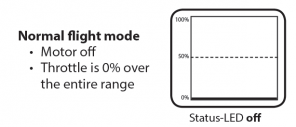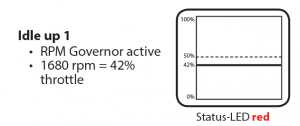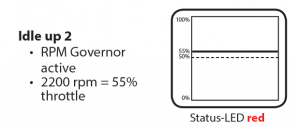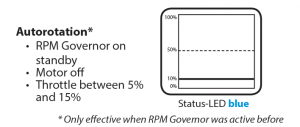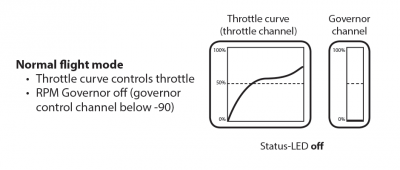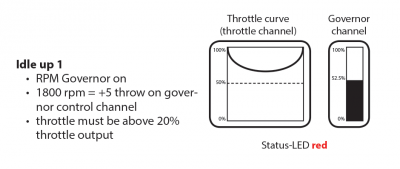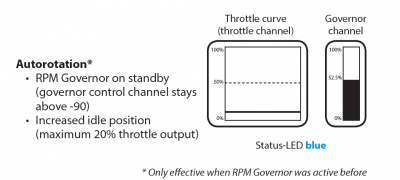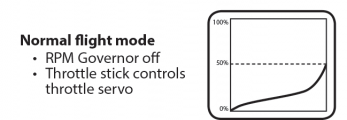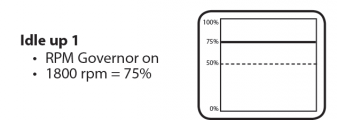Difference between revisions of "Manuals:MB Plus:Governormenu D"
Shornstein (talk | contribs) |
Shornstein (talk | contribs) |
||
| (4 intermediate revisions by the same user not shown) | |||
| Line 1: | Line 1: | ||
| − | |||
<translate> | <translate> | ||
| + | <!--T:1--> | ||
{{TOC_MBPlus}} | {{TOC_MBPlus}} | ||
{{DISPLAYTITLE:Governor setup menu point D|noerror}} | {{DISPLAYTITLE:Governor setup menu point D|noerror}} | ||
Similar to [[Manuals:MB_Plus:Governormenu_A/en|menu point '''A''']], menu point '''D''' only serves to give you some status information. At menu point D the different activation points of the RPM Governor will be displayed based on color and state of the Status-LED. So you can prepare your transmitter for use with the RPM Governor function. The information conveyed by the Status-LED is basically the same in every Governor operation mode. However, the setup of the transmitter will be slightly different, depending on whether the mode '''electric''' or '''nitro''' is used.<br /> | Similar to [[Manuals:MB_Plus:Governormenu_A/en|menu point '''A''']], menu point '''D''' only serves to give you some status information. At menu point D the different activation points of the RPM Governor will be displayed based on color and state of the Status-LED. So you can prepare your transmitter for use with the RPM Governor function. The information conveyed by the Status-LED is basically the same in every Governor operation mode. However, the setup of the transmitter will be slightly different, depending on whether the mode '''electric''' or '''nitro''' is used.<br /> | ||
| + | <br /> | ||
| + | __TOC__ | ||
<br /> | <br /> | ||
| − | ===Electric=== | + | ===Electric Governor=== <!--T:2--> |
| − | In '''electric''' mode the | + | In '''electric''' governor mode the pilot does no longer control the speed controller with the transmitter. MICROBEAST PLUS completely takes over control of the ESC. With the transmitter you only specifiy the desired rotor rpm you want the helicopter to maintain. When setting a rpm higher than zero, MICROBEAST PLUS will speed up the rotor smoothly and ensure that the demanded rotor rpm is kept constant throughout the flight. To practice autorotation landings, additionaly you can keep MICROBEAST PLUS in a special mode that causes the speed controller to be switched off during the maneuver but speed up the rotor rpm fast when aborting the autorotation (faster than with the initial soft start).<br /> |
<br /> | <br /> | ||
The rotor rpm is set via the throttle channel of the transmitter. You may use the transmitter‘s throttle curves for instance, so you can switch the motor on and off and pretend different speeds using the flight mode system of the transmitter. Instead of curves you only have to set horizontal lines so that the rotor rpm value does not depend on the throttle stick position but is fixed in each flight mode. The flight mode switch then acts as a switch that switches between different speed settings.<br /> | The rotor rpm is set via the throttle channel of the transmitter. You may use the transmitter‘s throttle curves for instance, so you can switch the motor on and off and pretend different speeds using the flight mode system of the transmitter. Instead of curves you only have to set horizontal lines so that the rotor rpm value does not depend on the throttle stick position but is fixed in each flight mode. The flight mode switch then acts as a switch that switches between different speed settings.<br /> | ||
<br /> | <br /> | ||
| − | + | <gallery mode="nolines" widths="300" heights="127"> | |
| − | In | + | File:EGov_normal_fm.png |
| + | File:EGov_idleup_1.png | ||
| + | File:EGov_idleup_2.png | ||
| + | File:EGov_hold.png | ||
| + | </gallery> | ||
| + | <br /> | ||
| + | In '''electric''' mode the adjustable throttle range is 3400 rpm/min. The lowest rotor speed that can be set is 600rpm/min, the maximum speed is 4000rpm/min. To enable autorotation bail out mode the throttle must be set to a value between 5% and 15%.<br /> | ||
<br /> | <br /> | ||
| − | + | {|style="text-align:center; margin:0px 0px 0px 480px" cellpadding="4" cellspacing="0" border="1" | |
| + | !colspan="2" | Throttle position<br />(scale depending on transmitter) | ||
| + | !style="width:100px;" | <br />Rotor rpm | ||
| + | !<br />Status-LED | ||
| + | |- | ||
| + | | 100% || +100 || 4000 | ||
| + | |style="background-color:#CC66CC; color:white" | '''purple''' | ||
| + | |- | ||
| + | | 95% || +90 || 3800 | ||
| + | | rowspan="17" style="background-color:#FF3300; color:white" | '''red''' | ||
| + | |- | ||
| + | | 90% || +80 || 3600 | ||
| + | |- | ||
| + | | 85% || +70 || 3400 | ||
| + | |- | ||
| + | | 80% || +60 || 3200 | ||
| + | |- | ||
| + | | 75% || +50 || 3000 | ||
| + | |- | ||
| + | | 70% || +40 || 2800 | ||
| + | |- | ||
| + | | 65% || +30 || 2600 | ||
| + | |- | ||
| + | | 60% || +20 || 2400 | ||
| + | |- | ||
| + | | 55% || +10 || 2200 | ||
| + | |- | ||
| + | | 50% || 0 || 2000 | ||
| + | |- | ||
| + | | 45% || -10 || 1800 | ||
| + | |- | ||
| + | | 40% || -20 || 1600 | ||
| + | |- | ||
| + | | 35% || -30 || 1400 | ||
| + | |- | ||
| + | | 30% || -40 || 1200 | ||
| + | |- | ||
| + | | 25% || -50 || 1000 | ||
| + | |- | ||
| + | | 20% || -60 || 800 | ||
| + | |- | ||
| + | | 15% || -70 || 600 | ||
| + | |- | ||
| + | | 10% || -80 | ||
| + | | rowspan="2" | Motor off/<br />Autorotation | ||
| + | | rowspan="2" style="background-color:#0066FF; color:white" | '''blue''' | ||
| + | |- | ||
| + | | 5% || -90 | ||
| + | |- | ||
| + | | 0% || -100 || Motor off | ||
| + | |style="background-color:black; color:white" | '''off''' | ||
| + | |}<br /> | ||
<br /> | <br /> | ||
| − | ===Nitro=== | + | ===Nitro Governor - with separate control channel=== <!--T:3--> |
| − | + | When the '''nitro''' Governor mode is used, the throttle servo can be controlled entirely via the throttle channel of the remote control as long as the RPM Governor is switched off. This is especially necessary to start and warm up the engine as well as to stop the engine after the flight. Only when the RPM Governor is switched on, the system will take over control of the throttle servo to spool up the rotor to the desired speed (if this is not yet reached) and ensure that the rotor speed is maintained during the flight. As some model engines react very sensitive in the lower throttle sector and abrupt engagement can cause the engine to quit, i.e. when the clutch is not fully engaged and/or the rotor is not yet turning, also the manual throttle control can be of advantage. The pilot can run the engine to speed "by hand" before control is passed over to the RPM Governor.<br /> | |
<br /> | <br /> | ||
Depending on whether an auxiliary channel was assigned to control the RPM Governor in Receiver setup menu or not, the RPM Governor is either controlled separately via this channel or you can control both RPM Governor and throttle servo alone by using the throttle channel of the transmitter. In general the adjustable throttle range in „nitro“ mode is 2400 rpm/min. The lowest head speed to govern is 600 rpm/min, the maximum head speed is 3000 rpm/min.<br /> | Depending on whether an auxiliary channel was assigned to control the RPM Governor in Receiver setup menu or not, the RPM Governor is either controlled separately via this channel or you can control both RPM Governor and throttle servo alone by using the throttle channel of the transmitter. In general the adjustable throttle range in „nitro“ mode is 2400 rpm/min. The lowest head speed to govern is 600 rpm/min, the maximum head speed is 3000 rpm/min.<br /> | ||
| Line 24: | Line 83: | ||
If a separate control channel is used for the RPM Governor the throttle servo can be controlled as usual via throttle channel and throttle curves of the transmitter. By switching the separate control channel in different positions, the RPM Governor can be activated and the desired rotor rpm can be preset. Note that for safety reason the throttle channel has priority over the RPM Governor when the output is below 25%. So you can always control the lower throttle servo positions by hand, even if the RPM Governor is already switched on. Then when the throttle is raised above 25% the RPM Governor intervenes and spools up the rotor. Also when you want to bring the throttle servo to idle position for autorotation or to shut off the engine you can always do this, regardsless of how the RPM Governor is switched. Anyhow keep in mind that MICROBEAST PLUS will be set to autorotation bail out mode if the RPM Governor is switched on and the throttle channel is brought below 25%. When throttle then is increased again, the RPM Governor will speed up the rotor faster than on initial spool up! Therefore if you make a stopover and the rotor is completely stopped, the RPM Governor must be completely disabled once by using the separate control channel. So the RPM Governor is reset and will perform an initial startup again. Otherwise if autorotation mode would still be active, the helicopter may tip over due to the abrupt speed up (this does not apply if you set the bail out spool up rate at [[Manuals:MB_Plus:Parametermenu_K/en|Parameter menu point '''K''']] as high as the initial spool up rate).<br /> | If a separate control channel is used for the RPM Governor the throttle servo can be controlled as usual via throttle channel and throttle curves of the transmitter. By switching the separate control channel in different positions, the RPM Governor can be activated and the desired rotor rpm can be preset. Note that for safety reason the throttle channel has priority over the RPM Governor when the output is below 25%. So you can always control the lower throttle servo positions by hand, even if the RPM Governor is already switched on. Then when the throttle is raised above 25% the RPM Governor intervenes and spools up the rotor. Also when you want to bring the throttle servo to idle position for autorotation or to shut off the engine you can always do this, regardsless of how the RPM Governor is switched. Anyhow keep in mind that MICROBEAST PLUS will be set to autorotation bail out mode if the RPM Governor is switched on and the throttle channel is brought below 25%. When throttle then is increased again, the RPM Governor will speed up the rotor faster than on initial spool up! Therefore if you make a stopover and the rotor is completely stopped, the RPM Governor must be completely disabled once by using the separate control channel. So the RPM Governor is reset and will perform an initial startup again. Otherwise if autorotation mode would still be active, the helicopter may tip over due to the abrupt speed up (this does not apply if you set the bail out spool up rate at [[Manuals:MB_Plus:Parametermenu_K/en|Parameter menu point '''K''']] as high as the initial spool up rate).<br /> | ||
<br /> | <br /> | ||
| − | + | <gallery mode="nolines" widths="400" heights="200"> | |
| + | File:NGov_normal_fm.png | ||
| + | File:NGov_idleup_1.png | ||
| + | File:NGov_hold.png | ||
| + | </gallery> | ||
| + | <br /> | ||
| + | {|style="text-align:center; margin:0px 20px 0px 360px; float:left" cellpadding="4" cellspacing="0" border="1" | ||
| + | !colspan="2" | Throttle position<br />(scale depending on transmitter) | ||
| + | !style="width:100px;" | | ||
| + | |- | ||
| + | | 100% || +100 | ||
| + | | rowspan="16" | Manual control/<br /><div style="color:#FF3300">RPM control</div> | ||
| + | |- | ||
| + | | 95% || +90 | ||
| + | |- | ||
| + | | 90% || +80 | ||
| + | |- | ||
| + | | 85% || +70 | ||
| + | |- | ||
| + | | 80% || +60 | ||
| + | |- | ||
| + | | 75% || +50 | ||
| + | |- | ||
| + | | 70% || +40 | ||
| + | |- | ||
| + | | 65% || +30 | ||
| + | |- | ||
| + | | 60% || +20 | ||
| + | |- | ||
| + | | 55% || +10 | ||
| + | |- | ||
| + | | 50% || 0 | ||
| + | |- | ||
| + | | 45% || -10 | ||
| + | |- | ||
| + | | 40% || -20 | ||
| + | |- | ||
| + | | 35% || -30 | ||
| + | |- | ||
| + | | 30% || -40 | ||
| + | |- | ||
| + | | 25% || -50 | ||
| + | |- | ||
| + | | 20% || -60 | ||
| + | | rowspan="5" | Manual control/<br /><div style="color:#0066FF">Autorotation</div> | ||
| + | |- | ||
| + | | 15% || -70 | ||
| + | |- | ||
| + | | 10% || -80 | ||
| + | |- | ||
| + | | 5% || -90 | ||
| + | |- | ||
| + | | 0% || -100 | ||
| + | |} | ||
| + | |||
| + | <!--T:4--> | ||
| + | {|style="text-align:center; float:left" cellpadding="4" cellspacing="0" border="1" | ||
| + | !style="width:100px;" | <br />Rotor rpm | ||
| + | !style="width:150px;" |Governor<br />channel | ||
| + | |- | ||
| + | |3000 || +100 | ||
| + | |- | ||
| + | |2874 || +90 | ||
| + | |- | ||
| + | |2747 || +80 | ||
| + | |- | ||
| + | |2621 || +70 | ||
| + | |- | ||
| + | |2495 || +60 | ||
| + | |- | ||
| + | |2368 || +50 | ||
| + | |- | ||
| + | |2242 || +40 | ||
| + | |- | ||
| + | |2116 || +30 | ||
| + | |- | ||
| + | |1989 || +20 | ||
| + | |- | ||
| + | |1863 || +10 | ||
| + | |- | ||
| + | |1737 || 0 | ||
| + | |- | ||
| + | |1611 || -10 | ||
| + | |- | ||
| + | |1484 || -20 | ||
| + | |- | ||
| + | |1358 || -30 | ||
| + | |- | ||
| + | |1232 || -40 | ||
| + | |- | ||
| + | |1105 || -50 | ||
| + | |- | ||
| + | |979 || -60 | ||
| + | |- | ||
| + | |853 || -70 | ||
| + | |- | ||
| + | |726 || -80 | ||
| + | |- | ||
| + | |600 || -90 | ||
| + | |- | ||
| + | |aus || -100 | ||
| + | |} | ||
| + | <div style="clear:both"> | ||
| + | </div> | ||
<br /> | <br /> | ||
| − | |||
<br /> | <br /> | ||
| + | |||
| + | ===Nitro Governor - simple mode=== <!--T:5--> | ||
If no separate control channel is used for the RPM Governor, throttle servo and RPM Governor are solely controlled by the throttle channel. For this purpose the control range of the throttle channel is divided into two parts: Below the center position, the throttle servo is controlled manually by the throttle channel. The RPM Governor is switched off and the servo output range is doubled, so that the throttle servo can be moved over the entire range. Once the throttle channel is moved (switched) to the upper area, the RPM Governor will activate, spool up the rotor and try to hold the preset rpm. Similar as it was described above for electric models you make the throttle curve a horizontal line, so that regardless of the position of the throttle stick MICROBEAST PLUS will always see the same throttle value and so the preset rpm will stays the same. So at least two flight phases are necessary. One that the throttle curve goes only up to the middle and in which the motor can be controlled by hand, i.e. for starting the motor and one flight phase that activates the RPM Governor and the throttle curve is used to preset the desired rotor head speed.<br /> | If no separate control channel is used for the RPM Governor, throttle servo and RPM Governor are solely controlled by the throttle channel. For this purpose the control range of the throttle channel is divided into two parts: Below the center position, the throttle servo is controlled manually by the throttle channel. The RPM Governor is switched off and the servo output range is doubled, so that the throttle servo can be moved over the entire range. Once the throttle channel is moved (switched) to the upper area, the RPM Governor will activate, spool up the rotor and try to hold the preset rpm. Similar as it was described above for electric models you make the throttle curve a horizontal line, so that regardless of the position of the throttle stick MICROBEAST PLUS will always see the same throttle value and so the preset rpm will stays the same. So at least two flight phases are necessary. One that the throttle curve goes only up to the middle and in which the motor can be controlled by hand, i.e. for starting the motor and one flight phase that activates the RPM Governor and the throttle curve is used to preset the desired rotor head speed.<br /> | ||
<br /> | <br /> | ||
| − | + | <gallery mode="nolines" widths="350" heights="120"> | |
| + | File:NGov_simple_normal_fm.png | ||
| + | File:NGov_simple_idleup_1.png | ||
| + | </gallery> | ||
| + | A third flight mode is used for auto-rotation: Here the throttle channel is constantly set to a value close below center position (between 40% and 50%) . When you switch to this flight mode once the governor was active, the throttle servo will be moved to the idle position set at menu point B. When switching back to governor mode, i.e. when you want to bail out from autorotation, the rotor will be spooled up at an increased rate (this does not apply if you set the bail out spool up rate at Parameter menu point K as high as the initial spool up rate - see chapter 8). Alternatively if it is switch back to the flight phase with manual control, autorotation mode is canceled and the next time you switch on the RPM Governor, the rotor is spooled up slowly.<br /> | ||
<br /> | <br /> | ||
| − | + | [[File:NGov_simple_hold.png|noframe|x145px]]<br /> | |
<br /> | <br /> | ||
| − | |||
<br /> | <br /> | ||
| − | + | {|style="text-align:center; margin:0px 0px 0px 180px" cellpadding="4" cellspacing="0" border="1" | |
| + | !colspan="2" | Throttle position<br />(scale depending on transmitter) | ||
| + | !style="width:100px;" | <br />Rotor rpm | ||
| + | !<br />Status-LED | ||
| + | |- | ||
| + | | 100% || +100 || 3000 | ||
| + | |style="background-color:#CC66CC; color:white" | '''purple''' | ||
| + | |- | ||
| + | | 95% || +90 || 2760 | ||
| + | | rowspan="10" style="background-color:#FF3300; color:white" | '''red''' | ||
| + | |- | ||
| + | | 90% || +80 || 2520 | ||
| + | |- | ||
| + | | 85% || +70 || 2280 | ||
| + | |- | ||
| + | | 80% || +60 || 2040 | ||
| + | |- | ||
| + | | 75% || +50 || 1800 | ||
| + | |- | ||
| + | | 70% || +40 || 1560 | ||
| + | |- | ||
| + | | 65% || +30 || 1320 | ||
| + | |- | ||
| + | | 60% || +20 || 1080 | ||
| + | |- | ||
| + | | 55% || +10 || 840 | ||
| + | |- | ||
| + | | 50% || 0 || 600 | ||
| + | |- | ||
| + | | 45% || -10 | ||
| + | | rowspan="2" | Manual control/<br />Autorotation | ||
| + | | rowspan="2" style="background-color:#0066FF; color:white" | '''blue''' | ||
| + | |- | ||
| + | | 40% || -20 | ||
| + | |- | ||
| + | | 35% || -30 | ||
| + | | rowspan="8" | Manual control | ||
| + | | rowspan="8" style="background-color:black; color:white" | '''off''' | ||
| + | |- | ||
| + | | 30% || -40 | ||
| + | |- | ||
| + | | 25% || -50 | ||
| + | |- | ||
| + | | 20% || -60 | ||
| + | |- | ||
| + | | 15% || -70 | ||
| + | |- | ||
| + | | 10% || -80 | ||
| + | |- | ||
| + | | 5% || -90 | ||
| + | |- | ||
| + | | 0% || -100 | ||
| + | |} | ||
<br /> | <br /> | ||
<br /> | <br /> | ||
Latest revision as of 09:02, 16 June 2015
Similar to menu point A, menu point D only serves to give you some status information. At menu point D the different activation points of the RPM Governor will be displayed based on color and state of the Status-LED. So you can prepare your transmitter for use with the RPM Governor function. The information conveyed by the Status-LED is basically the same in every Governor operation mode. However, the setup of the transmitter will be slightly different, depending on whether the mode electric or nitro is used.
Electric Governor
In electric governor mode the pilot does no longer control the speed controller with the transmitter. MICROBEAST PLUS completely takes over control of the ESC. With the transmitter you only specifiy the desired rotor rpm you want the helicopter to maintain. When setting a rpm higher than zero, MICROBEAST PLUS will speed up the rotor smoothly and ensure that the demanded rotor rpm is kept constant throughout the flight. To practice autorotation landings, additionaly you can keep MICROBEAST PLUS in a special mode that causes the speed controller to be switched off during the maneuver but speed up the rotor rpm fast when aborting the autorotation (faster than with the initial soft start).
The rotor rpm is set via the throttle channel of the transmitter. You may use the transmitter‘s throttle curves for instance, so you can switch the motor on and off and pretend different speeds using the flight mode system of the transmitter. Instead of curves you only have to set horizontal lines so that the rotor rpm value does not depend on the throttle stick position but is fixed in each flight mode. The flight mode switch then acts as a switch that switches between different speed settings.
In electric mode the adjustable throttle range is 3400 rpm/min. The lowest rotor speed that can be set is 600rpm/min, the maximum speed is 4000rpm/min. To enable autorotation bail out mode the throttle must be set to a value between 5% and 15%.
| Throttle position (scale depending on transmitter) |
Rotor rpm |
Status-LED | |
|---|---|---|---|
| 100% | +100 | 4000 | purple |
| 95% | +90 | 3800 | red |
| 90% | +80 | 3600 | |
| 85% | +70 | 3400 | |
| 80% | +60 | 3200 | |
| 75% | +50 | 3000 | |
| 70% | +40 | 2800 | |
| 65% | +30 | 2600 | |
| 60% | +20 | 2400 | |
| 55% | +10 | 2200 | |
| 50% | 0 | 2000 | |
| 45% | -10 | 1800 | |
| 40% | -20 | 1600 | |
| 35% | -30 | 1400 | |
| 30% | -40 | 1200 | |
| 25% | -50 | 1000 | |
| 20% | -60 | 800 | |
| 15% | -70 | 600 | |
| 10% | -80 | Motor off/ Autorotation |
blue |
| 5% | -90 | ||
| 0% | -100 | Motor off | off |
Nitro Governor - with separate control channel
When the nitro Governor mode is used, the throttle servo can be controlled entirely via the throttle channel of the remote control as long as the RPM Governor is switched off. This is especially necessary to start and warm up the engine as well as to stop the engine after the flight. Only when the RPM Governor is switched on, the system will take over control of the throttle servo to spool up the rotor to the desired speed (if this is not yet reached) and ensure that the rotor speed is maintained during the flight. As some model engines react very sensitive in the lower throttle sector and abrupt engagement can cause the engine to quit, i.e. when the clutch is not fully engaged and/or the rotor is not yet turning, also the manual throttle control can be of advantage. The pilot can run the engine to speed "by hand" before control is passed over to the RPM Governor.
Depending on whether an auxiliary channel was assigned to control the RPM Governor in Receiver setup menu or not, the RPM Governor is either controlled separately via this channel or you can control both RPM Governor and throttle servo alone by using the throttle channel of the transmitter. In general the adjustable throttle range in „nitro“ mode is 2400 rpm/min. The lowest head speed to govern is 600 rpm/min, the maximum head speed is 3000 rpm/min.
If a separate control channel is used for the RPM Governor the throttle servo can be controlled as usual via throttle channel and throttle curves of the transmitter. By switching the separate control channel in different positions, the RPM Governor can be activated and the desired rotor rpm can be preset. Note that for safety reason the throttle channel has priority over the RPM Governor when the output is below 25%. So you can always control the lower throttle servo positions by hand, even if the RPM Governor is already switched on. Then when the throttle is raised above 25% the RPM Governor intervenes and spools up the rotor. Also when you want to bring the throttle servo to idle position for autorotation or to shut off the engine you can always do this, regardsless of how the RPM Governor is switched. Anyhow keep in mind that MICROBEAST PLUS will be set to autorotation bail out mode if the RPM Governor is switched on and the throttle channel is brought below 25%. When throttle then is increased again, the RPM Governor will speed up the rotor faster than on initial spool up! Therefore if you make a stopover and the rotor is completely stopped, the RPM Governor must be completely disabled once by using the separate control channel. So the RPM Governor is reset and will perform an initial startup again. Otherwise if autorotation mode would still be active, the helicopter may tip over due to the abrupt speed up (this does not apply if you set the bail out spool up rate at Parameter menu point K as high as the initial spool up rate).
| Throttle position (scale depending on transmitter) |
||
|---|---|---|
| 100% | +100 | Manual control/ RPM control
|
| 95% | +90 | |
| 90% | +80 | |
| 85% | +70 | |
| 80% | +60 | |
| 75% | +50 | |
| 70% | +40 | |
| 65% | +30 | |
| 60% | +20 | |
| 55% | +10 | |
| 50% | 0 | |
| 45% | -10 | |
| 40% | -20 | |
| 35% | -30 | |
| 30% | -40 | |
| 25% | -50 | |
| 20% | -60 | Manual control/ Autorotation
|
| 15% | -70 | |
| 10% | -80 | |
| 5% | -90 | |
| 0% | -100 | |
Rotor rpm |
Governor channel |
|---|---|
| 3000 | +100 |
| 2874 | +90 |
| 2747 | +80 |
| 2621 | +70 |
| 2495 | +60 |
| 2368 | +50 |
| 2242 | +40 |
| 2116 | +30 |
| 1989 | +20 |
| 1863 | +10 |
| 1737 | 0 |
| 1611 | -10 |
| 1484 | -20 |
| 1358 | -30 |
| 1232 | -40 |
| 1105 | -50 |
| 979 | -60 |
| 853 | -70 |
| 726 | -80 |
| 600 | -90 |
| aus | -100 |
Nitro Governor - simple mode
If no separate control channel is used for the RPM Governor, throttle servo and RPM Governor are solely controlled by the throttle channel. For this purpose the control range of the throttle channel is divided into two parts: Below the center position, the throttle servo is controlled manually by the throttle channel. The RPM Governor is switched off and the servo output range is doubled, so that the throttle servo can be moved over the entire range. Once the throttle channel is moved (switched) to the upper area, the RPM Governor will activate, spool up the rotor and try to hold the preset rpm. Similar as it was described above for electric models you make the throttle curve a horizontal line, so that regardless of the position of the throttle stick MICROBEAST PLUS will always see the same throttle value and so the preset rpm will stays the same. So at least two flight phases are necessary. One that the throttle curve goes only up to the middle and in which the motor can be controlled by hand, i.e. for starting the motor and one flight phase that activates the RPM Governor and the throttle curve is used to preset the desired rotor head speed.
A third flight mode is used for auto-rotation: Here the throttle channel is constantly set to a value close below center position (between 40% and 50%) . When you switch to this flight mode once the governor was active, the throttle servo will be moved to the idle position set at menu point B. When switching back to governor mode, i.e. when you want to bail out from autorotation, the rotor will be spooled up at an increased rate (this does not apply if you set the bail out spool up rate at Parameter menu point K as high as the initial spool up rate - see chapter 8). Alternatively if it is switch back to the flight phase with manual control, autorotation mode is canceled and the next time you switch on the RPM Governor, the rotor is spooled up slowly.
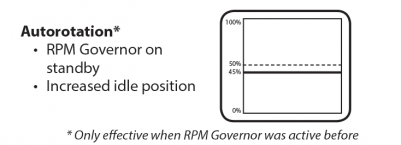
| Throttle position (scale depending on transmitter) |
Rotor rpm |
Status-LED | |
|---|---|---|---|
| 100% | +100 | 3000 | purple |
| 95% | +90 | 2760 | red |
| 90% | +80 | 2520 | |
| 85% | +70 | 2280 | |
| 80% | +60 | 2040 | |
| 75% | +50 | 1800 | |
| 70% | +40 | 1560 | |
| 65% | +30 | 1320 | |
| 60% | +20 | 1080 | |
| 55% | +10 | 840 | |
| 50% | 0 | 600 | |
| 45% | -10 | Manual control/ Autorotation |
blue |
| 40% | -20 | ||
| 35% | -30 | Manual control | off |
| 30% | -40 | ||
| 25% | -50 | ||
| 20% | -60 | ||
| 15% | -70 | ||
| 10% | -80 | ||
| 5% | -90 | ||
| 0% | -100 | ||
When finished briefly push the button to proceed to Governor setup menu point E.
